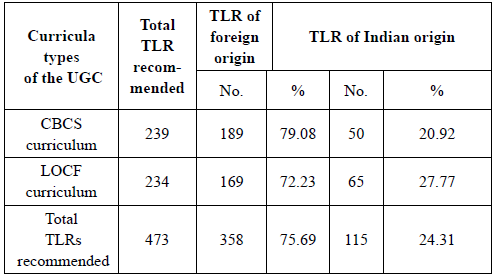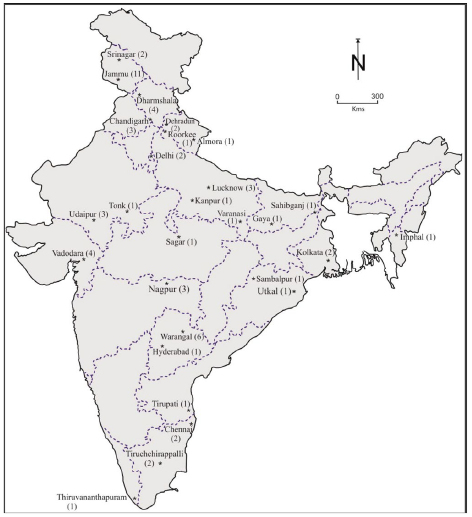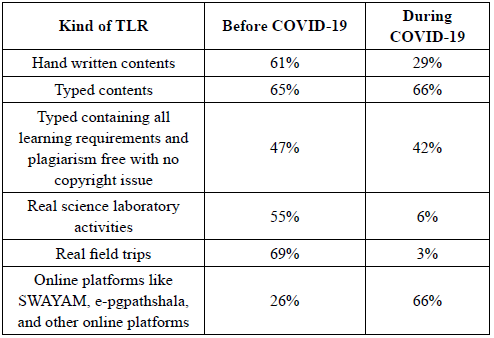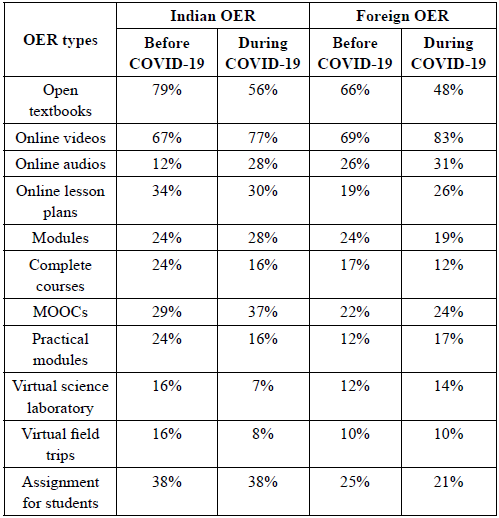1. Introduction
The usage of the word "Geology" in the scientific literature can be traced to the beginning of the eighteenth century (Howarth, 2020). In the late nineteenth century, the scope of the discipline of Geology was massively broadened in the Western World (King, 2008). As a result, different terminologies for the discipline of Geology came into existence. The new terms "Earth sciences" emerged in 1852; "Geoscience" appeared in 1929 and later, "Geological sciences" in 1938, in the geological literature (Wilson, 1883; Adams, 1938; Field, 1941; Howarth, 2020). All these words are synonymous with each other and broadly, involved in the study of the whole Earth and other planetary systems (Manduca & Kastens, 2012). Geology has been described as a historical and descriptive science, where processes and conditions of Earth, atmosphere, and oceans are investigated to understand Earth for the well-being of the society (Frodeman, 1995; Manduca & Kastens, 2012). It is a scientific discipline of societal relevance in meeting many of its needs notably, natural resources, environmental quality, and resilience to natural hazards (King, 2019). Geoscientists use current natural phenomenon data to understand Earth's past data to evaluate Earth's present conditions and together, predict how Earth will likely behave in the future. Thus, geological education is the backbone of the socio-economic development of any country, and the dissemination of its knowledge to the different individuals (learners, public, and policymakers), is crucial in the decision-making processes, and for the long-term survival of humanity on the Mother Earth.
Geology plays a significant role in the overall growth and development of society. In support of geological education, an International Geoscience Education Organization (IGEO) was formally established in 2000 (King, 2019). The main objectives of the IGEO are to promote geoscience education at the global level, enhance its quality and equity, and increase its awareness in all sectors of society at all levels (http://www.igeoscied.org/about-the-igeo/). In this context, eight international conferences on geoscience education have been organized worldwide so far by the IGEO since 1993 (http://www.igeoscied.org/activities/geoscied/). The IGEO is also promoting open online teaching geological resources encompassing Earth learning ideas, complete teaching units, and geoscience textbooks for the use of the global teaching-learning community in various international languages (King, 2008; http://www.igeoscied.org/teaching-resources/). Apart from this, the IGEO has been conducting International Earth Science Olympiad since 2007 for popularizing geoscience education among school kids (http://www.igeoscied.org/activities/ieso-2/).
Both, geological education and research are essential in India, because the Indian subcontinent is endowed with significant amounts of georesources, whilst research on its geological settings has proved to be valuable in unraveling various mechanisms of the Earth system and generation of the georesources of the subcontinent (Wadia, 1964; Tandon et al., 1991; Naqvi, 2005; Radhakrishna, 2005; Santosh, 2012; Valdiya, 2016; Searle & Treloar, 2019; Kumari et al., 2020). Geological research in India began in 1836 (Oldham, 1856), but, Geology as an independent educational science discipline first appeared in a few Indian universities in the 1890s (Murty, 1982). An analysis of the enrolment data for the Master's degree program in Geology shows that Geology is still a less popular science discipline in India. It also indicates that a majority of Teaching-Learning Resources (TLR) consisting of reading material used in higher geological education, are more of foreign origin, and may or may not be accessible to the teaching-learning community in India. Two types of negative impacts are visualized in the light of the current pandemic (i.e. COVID-19) on geological education, firstly, temporary suspension of classroom/face-to-face teaching, and secondly, the creation of an unfavorable environment for completing geological field-based compulsory assignments for Bachelor's and Master's degree programs.
Recently, Open Education Resources (OER) are becoming popular among science disciplines and the global teaching-learning community has been using them extensively in day-to-day teaching-learning practices (Smith, 2009; Henderson & Ostashewski, 2018; y Verma, 2021a). OER are also gaining importance in India and currently, there are a few OER in Geology, which are available on online platforms of the Government of India (GOI), for example, the e-pgpathshala portal of the University Grant Commission (UGC) and Swayam of the Ministry of Human Resources Development (MHRD) (https://epgp.inflibnet.ac.in/; https://swayam.gov.in/), and a few available on social media platforms like youtube. It has been shown that course-based-specific OER (including virtual labs, virtual field experiences, and Google Earth-based laboratory/field manuals) for Bachelor's and Master's degree programs in Geology are the need of the hour (Verma, 2021a). The use of OER in teaching-learning practice offers an opportunity to narrow down the gap of the TLR of Indian origin. OER provide off-campus specific-course-based learning during any pandemic like COVID-19, and also can, to an extent, facilitate the learners to complete their geological field-based assignments using Google Earth-based virtual field manuals. Research focusing on the past, present, and future of geological education is a major concern and is being carried out in the Western Hemisphere particularly, in the US and UK (King, 2008, 2018; GSA Position Statement, 2016; Dolphin et al., 2019). As a consequence, a journal has been launched, the "Journal of Geoscience Education" for publishing geological education research. To date, substantial research on geological education has not taken place in India, and probably, this article may be first of its kind in India. The primary objectives of this paper are threefold: first, to evaluate why geological education is necessary for the country and review its historical development; second, to assess the current popularity of Geology as a science discipline, the nature of available geological TLR, and impact of COVID-19 on higher geological education; and third, to evaluate OER role in providing high quality and equitable geological education, and in removing some of the educational barriers created by COVID-19.
2. Methodology
Two methodological approaches were adopted for this study. The first approach involved the collection and analysis of literature to evaluate the importance of imparting geological education, trace the development of geological education from 1851 to the present in India, evaluate the status of geological education in comparison with other sciences at the level of Master's degree programs, and finally, know the nature of geological TLR in India. It was found that almost all research dealing with the historical development of geological education in India was undertaken by historians. To date, no researcher with a geological background had investigated evolutionary development and the future of geological education in India.
The data dealing with the enrolment and successful completion of Master's degree programs in Geology, Physics, Chemistry, Botany, Zoology, and Environmental science for academic sessions from 2011-2012 to 20182019 was obtained from the annual reports of the Ministry of Human Resources and Development (now renamed as the Ministry of Education), GOI within the 'all India survey on higher education' available on its website (http://aishe.nic.in/aishe/reports); this allowed comparative analysis between Geology and other science disciplines. The data dealing with learners' enrolment and their successful completion in the Bachelor's degree programs are not available; therefore, Bachelor's degree programs were not included in this study.
We downloaded two curricula of Bachelor's degree programs in Geology from the website of the University Grant Commission and the curricula of Master's degree programs from 25 universities (including Central Universities and State/Union Territory Universities) from their websites to discover the nature of existing TLR. The number of TLR of foreign and Indian origin recommended in the above-mentioned curricula were counted and analyzed. We had not disclosed the names of 25 universities and presented them as anonymous because the purpose of the research was to evaluate the nature of TLR available or used in India. The second method followed was a structured online survey. A Google-based questionnaire dealing with the current use of the OER for geological teaching-learning practices in India, their role in overcoming the learning restrictions imposed by the prevailing COVID-19 pandemic, and enriching teaching-learning resources of Indian origin were prepared and sent by email to numerous academicians and researchers covering almost all parts of the country. The responses received were evaluated and interpreted.
Geological education: why it is important in India?
Indian geological education has many strategies for meeting the varied needs of society, addressing the economic growth of the country using natural resources, and refining basic and applied principles of Geology (Sharma, 1998; Radhakrishna, 2005; Sheth, 2007; Jain et al., 2016; Mandal, 2016; Mukherjee et al., 2016; Mazumder et al., 2019; Parsons et al., 2020). Since geological education includes the whole Earth system, geoscientists study where we get most of the things that we use in everyday life, such as minerals, soils, oil and natural gas, energy, air, water, and food (Radhakrishna, 2005; Press, 2008). Geo-professionals also play a critical role in numerous other societal services like the management of waste (sewage, water pollution, landfills, non-biodegradable, nuclear, and recycling), site selection for the construction of mega-projects (dams, tunnels, reservoirs, roads, rail tracks, and buildings) together with providing remedial measures for various environment-related problems. Geoscientists study natural hazards (earthquakes, tsunamis, volcanoes, landslides, subsidence, floods, heat waves, droughts, natural contaminations, cyclones, and severe storms) to determine the magnitude of their risks and to develop resilient societies where life and property losses are minimized and preparedness, mitigation and recovery are initiated (Shalley, 1971; Chakraborti et al., 2011; Mora, 2013; Mukherjee, 2019; Valdiya 2016; Fareeduddin et al., 2020; Ali et al., 2021; Verma 2021b; Prashanth & Verma 2022). In today's world, due to the rapid increase in population and unsustainable practices in the use of natural resources, there is tremendous stress on Earth's resources, causing many problems such as climate change, global warming, fossil fuels scarcity, natural resources depletion, biodiversity loss, extreme weather events, water contamination, and air pollution. Thus, nowadays, geo-professionals have been working to resolve various Earth and environment-related issues whilst ensuring sustainability in the use of natural resources, and their protection for future generations (Häggquist & Söderholm, 2015; Valdiya, 2016). Additionally, geological education has important societal implications in improving human health standards and the environment by suggesting key remedial measures to reduce the impact of geogenic elements and anthropogenic interventions in the Earth's natural environment. The geogenic contaminants of groundwater, especially fluoride and arsenic, pose a serious threat to human health in India (Ali et al., 2016; Ali et al., 2021). The endemic fluorosis caused due to high concentration of fluoride in groundwater was recognized in 1937 and arsenic contaminated health effects in the year 1976. However, groundwater was not properly investigated for these contaminants until the late 1990s, resulting in the poor health of millions of people in India (Chakraborti et al., 2011; Raju, 2017; Ali et al., 2019; Saha et al., 2021).
The awareness of geological time, the evolution of life, and Earth's past environments through the deep time is critically useful for society in view of the alternative perspectives of myths and religions that help us to understand how to live in harmony with the Earth (Ayala, 2008; Kölbl-Ebert, 2009). Overall, geological education, information, and guidance play key roles in the decision-making process in numerous societal services such as sustainable natural resources management, mega-structures construction, natural hazards mitigation and management, local and regional planning, and environmental impact assessments (Häggquist & Söderholm, 2015). Geological education is also critical in meeting some of the sustainable development goals of the United Nations (UN) such as zero hunger, good health and well-being, clean water and environment, infrastructure, sustainable cities, climate action, and sustainable marine resources (UN, 2015; Stewart & Gill, 2017).
Apart from education, geological research on the Indian lithospheric plate provides a platform for generating new geological ideas and offers many opportunities to study the geodynamics of the Earth on the global scale (Tandon et al., 1991; Radhakrishna, 2005; Naqvi, 2005; Jain et al., 2016; Santosh, 2012; Mandal, 2016; Mukherjee et al., 2016; Valdiya, 2016; Searle & Treloar, 2019; Parsons et al., 2020). The Indian subcontinent has a distinctive topography with the Indian Ocean lying to the south and the snow-covered Himalayan mountains belt to the north. It includes three main physiographic divisions (Fig. 1): peninsular India to the south, extra-peninsular India (i.e., Himalayan division) to the north, and the Indo-Gangetic plains sandwiched between them (Shah, 2018). The Indian lithospheric plate preserves the vast history of the Earth from Archean to Holocene (4.6 billion years to the present) in its rock record (Naqvi, 2005; Santosh, 2012; Mohanty, 2015; Valdiya, 2016; Shah, 2018). The peninsular region of India is dominantly composed of rocks of the Precambrian age and is an amalgamation of Archean cratons (Dharwar, Bastar, Singhbhum, Bundelkhand, Aravalli, and Meghalaya), and Proterozoic mobile belts (Eastern Ghat, Pandyan, Satpura, and Aravalli-Delhi) and sedimentary basins (Vindhyan, Kurnool-Cuddapah, Chhattisgarh, Gwalior, Pakhal, Marwar, Bhima, and Kaladgi) (Fig. 1; Valdiya, 2016; Shah, 2018). The cratons and mobile belts suffered various phases of Archean tectonic activity and as a consequence, they are a rich storehouse of varied economic minerals, building and industrial materials, gemstones, and decorative stones, and are excellent sites for investigating Precambrian tectonism. The Proterozoic sedimentary successions have yielded much biotic evidence, which is useful in studying the early evolution of Earth's life and atmosphere (Naqvi, 2005; Kumar, 2010; Santosh, 2012; Mohanty, 2015; Valdiya, 2016; Shah, 2018; Mazumder et al., 2019; Fareeduddin et al., 2020).
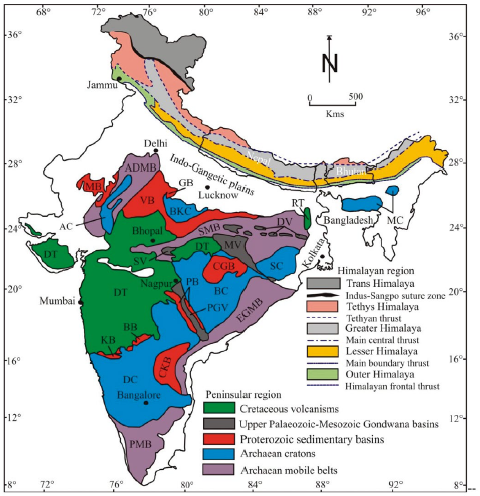
Figure 1 Map of India showing the main physiographic divisions and geological units (modified after Kumar, 2010; Valdiya, 2016; Shah, 2018). DC stands for Dharwar craton, BC Bastar craton, SC Singhbhum craton, BKC Bundelkhand craton, AC Aravalli craton, MC Meghalaya craton; PMB Pandyan mobile belt, EGMB Eastern Ghat mobile belt, SMB Satpura mobile belt, ADMB Aravalli-Delhi mobile belt; CKB Cuddapah- Kurnool basin, CGB Chhattisgarh basin, KB Kaladgi basin, BB Bhima basin, PB Pakhal basin, VB Vindhyan basin, GB Gwalior basin, MB Marwar basin; PGV Pranhita-Godavari valley, MV Mahanadi valley, DV Damodar valley, SV Satpura valley; DT Deccan traps, and RT Rajmahal traps.
Prominent rift valleys such as Pranhita-Godavari, Satpura, Mahanadi, and Damodar (Fig. 1) probably developed during Proterozoic times, where thick sedimentary covers developed within these valleys that are termed Gondwana basins containing huge deposits of coal and a wealth of animal and plant fossils over Upper Palaeozoic to Mesozoic time intervals (Naqvi, 2005; Valdiya, 2016; Fareeduddin et al., 2020). The fossils of Gondwana deposits have provided data enabling the reconstruction of land ecosystems of Upper Palaeozoic to Mesozoic of peninsular India, together with their interrelations with ecosystems of continents that were adjacent at the time (Valdiya, 2016). The prominent Cretaceous volcanic traps (Rajmahal and Deccan) offer opportunities to study the interior of the Earth, the role of mantle plumes in the rifting and drifting of the former Gondwanan continents, the movement rate of the Indian plate, and the environmental impacts of volcanic eruption on contemporary biota (Beane et al., 1986; Courtillot, 1990; Verma, 2015; Verma et al., 2016, Mukherjee et al., 2016; Verma & Khosla, 2019; Kania et al., 2022; Khosla et al., 2022). The coastal regions of India contain a considerable cover of sedimentary successions such as Bombay high (Maharashtra), Cambay basin (Gujarat), Assam shelf (Assam), and Krishna-Cauvery basins (south India) largely formed in response to marine transgression and regression during Cenozoic time, and have provided valuable sources of lignite, coal, oil and natural gas (Biswas, 1982, 1987; Nagendra et al., 2011; Shah, 2018). These allow us to study the phenomenon of the past sea level changes concerning changes in paleoclimate (Naqvi, 2005; Kundal & Humane, 2007; Valdiya, 2016; Fareeduddin et al., 2020 y Verma, 2021b).
The Himalayan mountains belt, which is a product of the India-Asia collision that took place in Eocene times, created a unique monsoon system, and provided numerous natural resources, together with increased risks of natural hazards across the Indian subcontinent (Sharma, 1998; Valdiya, 2016; Searle & Treloar, 2019; Parsons et al., 2020). The monsoon system is a boon for the agro-economic sector of the subcontinent. There are opportunities to study the monsoon system to understand its mechanisms and the influence of the El Niño-Southern Oscillation cycle on it (Das, 2015; Dimri et al., 2016). The complex geological framework of the Himalayan makes it as an astonishing natural laboratory to investigate pre-, post-, and syn-collisional and depositional events associated with geodynamics of the Indian lithospheric plates and their influence on the environment. The rich fossiliferous Palaeozoic-Mesozoic successions of the north-western Himalaya provide excellent rock outcrops for investigating the biological evolution of invertebrates (corals, mollusks, brachiopods, echinoderms). The Himalayan Cenozoic successions contain well-preserved vertebrate fossils (particularly of mammals), which are useful for reconstructing mammalian diversity and their bearing on paleoecology, paleoenvironment, and paleobiogeography of the Indian subcontinent (Naqvi, 2005; Valdiya, 2016). The Himalayan contains large regions of glaciers, snow, and ice that serve as a significant freshwater reserve in Asia and provide uninterrupted water supply to the nine river systems of Asia, and these give a lifeline for nearly one-third of humanity. Climate change is seriously impacting the snow and ice cover of the Himalayan ecosystem, which needs to be investigated (Bisht et al. 2019; Sabin et al., 2020). The Himalaya is divided into five tectonic belts from north to south: Trans, Tethys, Greater, Lesser, and Outer Himalaya (Fig. 1). Each belt is bounded by prominent tectonic features such as Tethyan, Main Central, Main Boundary, and Himalayan Frontal Thrusts (Naqvi, 2005; Valdiya, 2016). These thrusts are seismically active zones and any tectonic movement along these thrusts can cause serious natural hazards such as slope instability, landslides, and earthquakes (Rajendran et al., 2017; Prashanth et al., 2021). A vast majority, around 75%, of total global landslides occur in the Asian continent alone, with a significant number of landslide events occurring along the Himalaya mountain belts (Froude & Petley, 2018). Thus, the Himalayan region provides unique opportunities for studying plate movements, plate boundaries, seismicity, neotectonics, slope stabilization, soil erosion proneness, climate change, glacial melting, harnessing geological resources, and mountain building processes (Jain & Sinha, 2005; Rajendran et al., 2017; Prashanth et al., 2021, 2022; Kouser et al., 2022; Tandon, 2022).
The vast Indo-Gangetic plains of northern India comprise recent sediments, which were brought down from the rising Himalayan by its various rivers (Tandon et al., 1991; Tandon, 2022). These plains contain enormous water resources and their sediments have made the soil cover of the plains very fertile and so suitable for agriculture and industrial activities. As a result, nearly 50% of the total food grain production to feed 40% population of India comes from these plains (Pal et al., 2009). These plains are currently facing alarming amounts of soil degradation and water contamination (Mythili & Goedecke, 2016). The Great Thar Desert of Western India is an active area for exploring mineral resources and for harnessing renewable energy such as solar and wind. Thus, geoscientific research plays an influential role in studying the availability and spatial distribution of natural resources, regions of natural hazards, environment-related issues, and sustainable natural resources management, which are of direct concern to the society.
Historically, the importance of the geological richness of the country was understood in earlier times by the Mughal Empire, and as a result, they ruled the subcontinent for 332 years from 1526 to 1858 (Babu & Nautiyal, 2013). Meanwhile, Britishers (i.e. East India Company) invaded the country in 1757, and later, expanded their imperialism, and ruled the country from 1858 to 1947 (Wagh, 2018). They understood mineral resource richness, especially the coal resources of the country, and extensively mined several mineral resources during their rule (Fox, 1947). The country still has many georesources. Some world-famous diamonds namely, Kohinoor, Great Moghul, and Regent were discovered from gravels ofthe Krishna valley that were derived from the Krishna lamproite (ultramafic igneous rock) field, near the north-eastern margin of the Cuddapah Basin, southern India (GSI, 2011). Recently, geoheritage emerged as an important field of public and scientific interest that promotes geoscience education, research, geotourism, and sustainable development. Geoheritage is an essential part of the natural (geocultural) heritage and encompasses "geosites of significant educational, cultural, scientific, and aesthetic value" (https://www.americasgeoheritage.com/geoheritage/). India has numerous rich and diversified geocultural heritage sites and thus, provides ample opportunities to promote education, research, and tourism related to geoheritage (Shekhar et al., 2019; Biswas & Chauhan, 2021; Chauhan et al., 2021). The GSI has recognized 26 geological sites as National Geological Monuments of India that are located in various geologically rich states such as Andhra Pradesh, Telangana, Chhattisgarh, Gujarat, Himachal Pradesh, Karnataka, Kerala, Odisha, Rajasthan, Maharashtra, and Tamil Nadu (INTACH, 2016). However, there are numerous geoheritage sites are in India, which are yet to be recognized (Fig. 2).
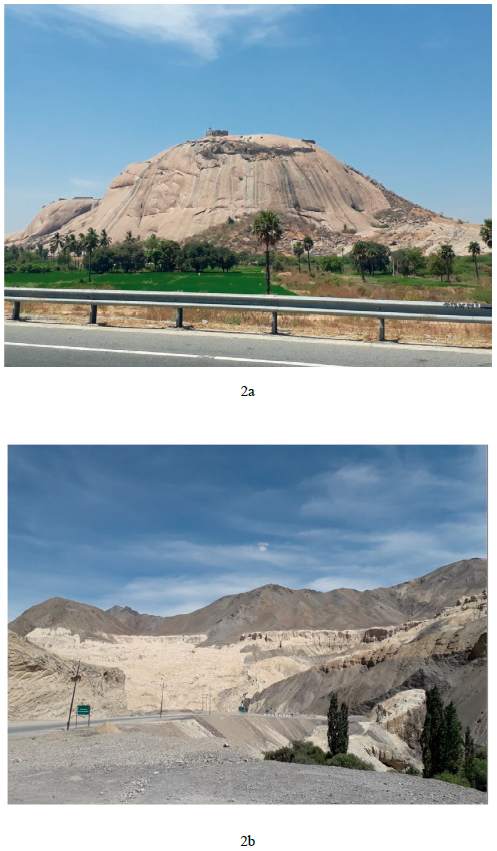
Figure 2 Photographs showing potential geoheritage sites in India. a. Huge granite batholith, situated nearly 50 km from Hyderabad along the Hyderabad-Warangal national highway at Bhongir town, Telangana, South India. This batholith is a part of the Eastern Dharwar Craton and around 2.7 to 2.5 billion years old. b. Quaternary fluvio-lacustrine deposits at Lamayuru, Union Territory of Ladakh, Northern India. These deposits are 105 m thick, dominantly composed of clay and sand layers, which develop a lunar landscape at Lamayuru. These deposits are popularly known as "moonland" of the Lamayuru. Both these geosites are places of tourist's attraction (Courtesy: Naveen Kumar, Geologist, Geological Survey of India for b).
Given this wide geological background, geological education is crucial for India to refine existing geological principles, establish geoheritage sites, explore georesources and ensure their sustainability, and resolve geo-environment-related problems across the country.
Development of Indian higher geological education
The study of geological phenomena in India had been recorded from time immemorial when Indians started to observe and record the behavior of Earth's natural processes. The Bronze Age and Iron Age, which were associated with the growth and development of human civilizations and their presence in the country, clearly indicate the exploration and utilization of mineral resources by ancient Indians. There are several references for using basic concepts of Geology and Metallurgy in the ancient literature of the country. However, reliable evidence of the early existence of geological information and its utilization for the development of society comes from an old Treatise "Arthashastra", composed by an ancient Indian statesman and philosopher, Kautilya, around 321-296 BC (Chakraborty, 1970; Murty, 1979). This Treatise provides an account of geological knowledge, which is used to discover and extract metals from various ores (GOI, 2012). The growth of Geology as an independent science discipline emerged in the eighteenth century (Chakraborty, 1971; Rajendran, 2019). The initial phase of realization of the importance of Geology in India was seen with the establishment of the Survey of India in 1767 and the Asiatic Society of Bengal in 1784 by the East India Company. The main objective of the Survey of India was to map the country and produce maps at different scales for discovering natural resources and Society had as its objective "enquiry into the history and antiquities, arts, science and literature of Asia" (Chakraborty, 1971). The results of the survey and society together later played a profound role in the growth of geological studies in India. The opening of a museum in Calcutta (now Kolkata) in 1840 by the East India Company was considered a step towards the beginning of geological education (Stubblefield, 1970). Indeed, the East India Company understood the importance of the geological richness of India, especially the coal resources before 1835. As a consequence, they established a Coal Committee in 1836 for discovering the coal and mineral resources of the country (Kumar, 1982).
Based on the rich and varied geology of the subcontinent, with its huge resource potential, the East India Company formally established the world's second-largest organization, the Geological Survey of India (GSI) in 1851, to undertake geological mapping and exploration of mineral resources of the country (Oldham, 1856). In 1858, the East India Company developed into the British Raj (i.e. Government of colonial India). But before the 1850s, the colleges of the East India Company taught Geology and Mineralogy, but there was no separate department of Geology (Larwood, 1958; Tolman, 2016).
The opening of the GSI marked the informal beginning of geological higher education in India (Kumar, 1982; Murty, 1982; Palit, 2013). Shortly after its establishment, Henry B. Medlicott, an Irish geologist, came to India in 1854 to become a Professor of Geology at the Thomson College of Civil Engineering, Roorkee (now Indian Institute of Technology, Roorkee) founded in 1847. He was probably the first teacher of Geology in India. For a long period, British geologists undertook all activities of the GSI and they were of the view that Indians were not capable of doing any kind of sophisticated teaching and research in Geology, and no Indian university was properly equipped to impart higher geological education. In fact, they were not much interested to open geological education in the higher learning institutes of India (Kumar, 1982; Tolman, 2016). As a consequence, geological education did not become part of higher education in Indian universities until the 1870s (Kumar, 1982; Tolman, 2016). Over time, the British Raj found difficulties in recruiting geologists from Europe because they rejected the offer of British Raj to join GSI due to limited financial benefits and serious health problems in India; particularly, unfavorable climatic conditions, which often caused their death within a few years ofjoining the GSI (Grout, 1995; Kumar, 1995). This led to a shortage of geologists in the GSI and to fill this gap, the British Raj decided to recruit Indian geologists. In 1886, the British Raj constituted two positions exclusively for Indian geologists within the GSI and also felt the need to establish a sound education system to teach Geology (Kumar, 1995).
To fill the shortage gaps of geologists and associated skilled manpower needed in the GSI and through continuous struggle by the Indian educationists, a more systematic effort was made by the British Raj and GSI for opening the Geology departments at the Presidency Colleges of Kolkata and Madras (now Chennai), and Bombay University in the 1890s (Murty, 1982). Geology as an optional subject was introduced at Bombay University in 1879. In 1892, a separate department of Geology was opened at the Presidency College (now Presidency University), Kolkata. Another Presidency College (now Madras University) at Chennai already had Geology as an auxiliary subject, but an independent department of Geology was started in 1910 (Murty, 1982). Meanwhile, the spread of geological education also reached northern India with the visit of the Prince of Wales to Jammu in 1906. To commemorate his visit, His Highness, the Maharaja (i.e. ruler) Sir Pratap Singh of Jammu and Kashmir, built the Prince of Wales College (now Government Gandhi Memorial Science College and is a part of the Cluster University of Jammu) on the banks of the River Tawi. In this college, Geology education commenced in 1907, under the stewardship of the renowned Indian geologist, Dr. D. N. Wadia (Stubblefield, 1970). Over time, many Geology departments were opened in other universities namely, Banaras Hindu University, Varanasi in 1923; Indian School of Mines (now Indian Institute of Technology), Dhanbad in 1926; Andhra University, Visakhapatnam in 1941; Lucknow University, Lucknow in 1942; Aligarh Muslim University, Aligarh in 1946; Patna University, Patna in 1946, and Rashtrasant Tukadoji Maharaj University, Nagpur in 1946 (Stubblefield, 1970; Bhattacharya, 2016). Thus, the development of geological education was seen as a by-product of the GSI growth and rich georesources of the country.
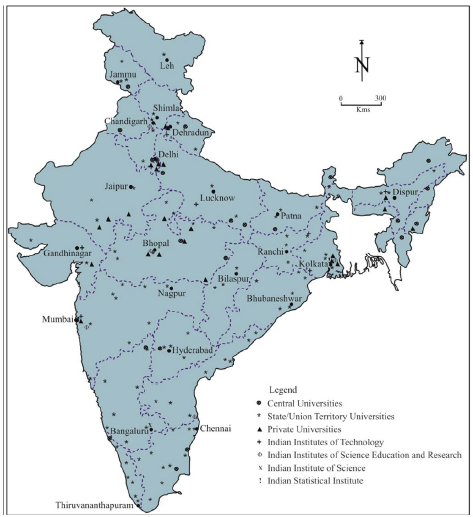
Figure 3 Map of India showing the distribution of higher learning institutes offering geological education in India.
There were around 14 universities in the country that offered geological education before1952 (Stubblefield, 1970). Following one and a half decades of independence, out of a total of 35 universities, around 20 had departments of Geology (Wadia, 1964). Later, geological education witnessed a substantial expansion, thus, many Geology departments were opened in various colleges and universities across the country. At present, there are more than 153 higher learning institutes that host Geology departments imparting geological education in India up to a Master's degree level (excluding colleges). These institutes include various universities (state/union territory, central and private), Indian Institutes of Technology, Indian Institute of Science, Indian Statistical Institute, and Indian Institutes of Science Education and Research (Fig. 3). Apart from conventional learning systems, geological education is also offered through open and distance modes of learning in India, with the opening of departments at Dr. B. R. Ambedkar Open University in 1991, and Indira Gandhi National Open University in 2010. Currently, higher education in Geology is being offered at three-degree levels across the country viz., Bachelor's degree programs of three-year duration, Master's degree programs of two-year duration, and integrated Bachelor's-Master's degree programs of five-year duration. Apart from this, Ph.D. in Geology is a common research degree program in Indian universities.
The need for geology education at the school level in India was first highlighted by Wadia in 1964 (Stubblefield, 1970). So far, the picture of geology education offered at the school level is very sparse; it is largely neglected in comparison with other science disciplines: Physics, Chemistry, Mathematics, Biology, Engineering, and Computer science (Tandon, 2005). From kindergarten to 10th grade of high school level (pupils with age range 4 to 16 years), geology education is taught as a part of either general studies or social sciences (Paliwal, 2005). In 11th and 12th grade higher school education (pupils with age range 16 to 18 years), there are very few school boards of Indian states/union territories offering Geology as an independent subject in their science or arts streams. The states/union territories that do so are Kerala, Rajasthan, Jammu and Kashmir, Jharkhand, Karnataka, Maharashtra, and Manipur (Paliwal, 2005; Padmanabhan, 2018).
Status of Geology education among other sciences: a comparative analysis
Numerous public and private sectors including non-governmental organizations in India offer job opportunities to those who had qualified with a Master's degree in Geology. Thus, an analysis was carried out to evaluate the performance of Master's degree programs in Geology, in terms of the successful completion of the program by learners and to make comparisons between the Master's degree programs in Geology and other science disciplines to evaluate the percentage of their success rate and to ascertain awareness of Geology among the learners. For this analysis, five science disciplines comprising Physics, Chemistry, Botany, Zoology, and Environmental science were selected. The data about the learners' enrolment and their successful pass rates (i.e. completion of programs) for the academic sessions from 2011-2012 to 2018-2019 of Master's degree programs in Geology, Physics, Chemistry, Botany, Zoology, and Environmental science was obtained from reports of the MHRD, GOI on "all India survey on higher education" (Table 1).
Analysis of the data shows that there was an increasing trend in enrolment numbers of learners in the Master's degree programs of all six science disciplines in the academic sessions 2011-2012 to 2018-2019 (Table 1). Nearly 40.86% of learners were enrolled in the Master's degree program in Chemistry whilst a minimum of learners, at 2.16%, were enrolled in the Master's degree program in Geology (Fig. 4a). Surprisingly that the importance of Geology in India was realized in 1851 with the establishment of the GSI, but the enrolment percentage of the Master's degree program in Geology indicates that Geology had the lowest popularity as a science subject among these six science disciplines (Fig. 4a).
Table 1 Learner's enrolment and successful completion data of Master's degree programs in Geology, Physics, Chemistry, Botany, Zoology, and Environmental science (complied after MHRD Reports, 2014, 2015a, b, 2016a, b, 2017, 2018, 2019).
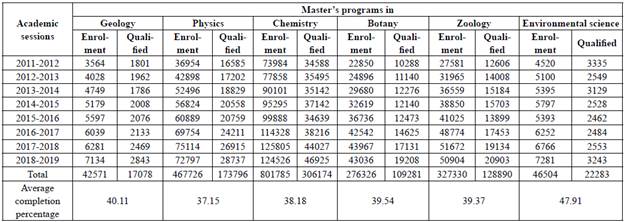

Figure 4 a. Pie-chart showing relative enrolment data percentage for Master's degree programs in six science disciplines of academic sessions from 2011-2012 to 20182019. b. Bar-chart showing average successful completion percentage of learners in Master's programs in six science disciplines of academic sessions from 2011-2012 to 2018-2019. Refer to Table 1 for enrolment data. Env sci stands for Environmental science.
Further data analysis of learner's enrolment and their successful completion in Master's programs in all six science disciplines from 20112012 to 2018-2019 had given quite interesting results (Fig. 4b). The results indicate that the Master's degree program in Geology had a very good learner's average completion rate i.e. 40.11%, and stands second, after average program completion rate of Environmental science, which is 47.91% (Fig. 4b). The average successful program completion rate for Botany, Zoology, and Chemistry was 39.59%, 39.37%, and 38.18%, respectively. Physics had the lowest average completion rate, which is 31.15% (Fig. 4b). This may indicate that better quality education was available to the qualified learners of the Master's program in Geology, and alternatively, reflects a higher quality of qualified postgraduates of Geology. The Union Public Service Commission (UPSC) of the GOI recruits candidates who had Master's degrees in Geology as geologists for the GSI almost every year. The applicants from all over the country appear for the UPSC written examination to obtain geologist positions in the GSI after completing their Master's degree in Geology. Thus, the performance of applicants in the UPSC geologists' written examination can provide a means of checking the quality of masters-level geological education in India. In the past few years of the UPSC recruitment process for geologists had shown that the subject-specific knowledge of the applicants was a little low and applicants were securing average marks in the written examination, i.e. 30 to 40% (Saha, 2016, 2018).
Nature of Teaching-Learning Resources in Geology
Over the past few years, several reforms in the country's higher educational system had been made by the UGC and Department of Higher Education of the MHRD of the GOI. Recently, the UGC implemented a minimum course curriculum under, the Choice-Based Credit System (CBCS) and Learning Outcomes-Based Curriculum Framework (LOCF) for Bachelor's degree programs in India to provide high-quality and equitable education (UGC, 2015a, 2019). Under the CBCS and LOCF, the UGC issued a national curriculum in Geology for implementation in Bachelor's (both general and honors) degree programs for all higher education institutes in India (UGC, 2015b, c, 2019). The MHRD had taken several remarkable steps in enhancing the quality and providing equity with extensive use of Information and Communication Technology (ICT) in higher education. Nowadays, online higher education is also being offered to learners through Massive Open Online Courses (MOOCs) through various online platforms (http://www.sakshat.ac.in). In addition, TLR in the form of the OER in various disciplines for the use of teachers and learners have also been provided by the GOI (e.g., https://epgp.inflibnet.ac.in/).
To know the nature of the TLR in Geology for its Bachelor's and Master's degree programs, the TLR recommended for all the courses of these programs were evaluated. For Bachelor's degree programs, the TLR mentioned in UGC-CBCS and LOCF in Geology, in the form of recommended books/texts, were evaluated (Table 2). For Master's degree programs, the Master's curricula of 25 universities (including five universities each from northern, western, southern, eastern, and central regions of India) were downloaded from their respective websites, and the TLR were recommended for all courses of programs were evaluated (Table 3).
The analysis of recommended TLR by the UGC for Bachelor's degree program in Geology under its CBCS and LOCF schemes shows that 75.69% of the TLR listed in the syllabi are of foreign origin, and only 24.31% are of Indian origin (Table 2; Fig. 5a). Similarly, the analysis of recommended TLR in the syllabi of Master's degree programs in Geology of 25 universities of five Indian regions namely, northern, western, southern, eastern, and central shows that these regions contain 81.36%, 81.05%, 78.30%, 80.20%, 76.29%, and 18.64%, 18.95%, 21.70%, 19.80%, 23.71% TRL of foreign and Indian origin, respectively (Table 3; Fig. 5b). As a whole, the recommended TRL of these 25 universities include 79.68% of foreign origin, and only 20.32% of Indian origin (Table 3; Fig. 5b). A few of the MOOCs in Geology such as Physical and Structural Geology, Stratigraphy and Palaeontology, Crystallography and Mineralogy, Photogeology and Remote Sensing, Metamorphic Petrology and Thermodynamics, Metamorphic Petrology, and Environmental Geology are on offer through the UGC-MOOCs portal (http://ugcmoocs.inflibnet.ac.in/ugcmoocs/moocscourses.php). In addition, some modules related to geological courses namely, Igneous and Metamorphic Petrology, Sedimentology and Petroleum Geology, Crystallography and Mineralogy, Economic Geology and Mineral Resources of India, Hydrogeology and Engineering Geology, Remote Sensing and Geographic Information System are available as open TLR at e-pgpathshala portal of the UGC (https://epgp.inflibnet.ac.in/Home/ViewSubject?catid=448).
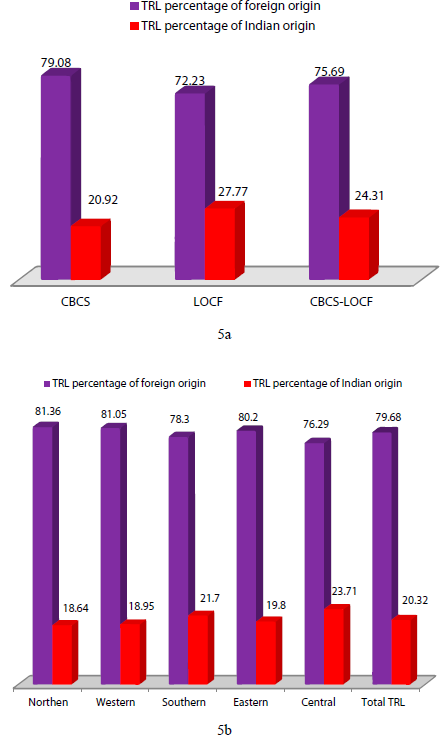
Figure 5 a. Bar-chart showing percentage of the TLR recommended in the curricula issued by the UGC under its CBCS and LOCF schemes for Bachelor's degree programs in Geology. b. Bar-chart showing the percentage of TLR recommended in the curricula of 25 universities across India for their Master's degree programs in Geology. Refer to Table 2 for the TLR data.
Table 3 Statistics of the TLR recommended for Master's program in Geology covering all parts of India. The letters A to Y have been sequentially assigned to these universities within parentheses for identification purposes as their names have been kept anonymous.
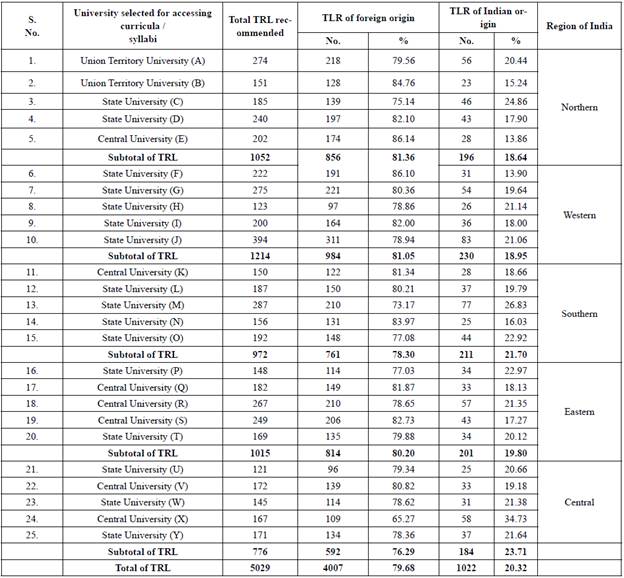
Overall, data indicate that a majority of the TLR for higher education programs in Geology in India are of foreign origin. These resources are costly for learners and may or may not be sufficient to meet all content requirements of the various courses in the programs. Geology is a distinctive and field-based science discipline so a majority of its courses are based on the geological setting of the country. Therefore, the teaching-learning practice of such courses usually demands TLR of Indian origin (Wadia, 1916; Krishnan, 1949; Kumar, 2010; Mishra, 2016; Shah, 2018). The need to develop TLR of Indian origin taking the Indian geological setting into account has been highlighted by various workers (Wadia, 1919; Mishra, 2016; Kumar, 2010; Verma, 2017, 2018, 2019, 2021; Shah, 2018). The recent development of TLR in the form of MOOCs and modules of e-pgpathshala of the UGC are progressive steps taken to enrich TLR of the Indian origin for some Geology courses, but these resources are still meagre and need to be added extensively.
COVID-19 pandemic and geological higher education: Challenges and opportunities
The Corona virus disease 2019 (COVID-19) was declared a global pandemic by the World Health Organisation (WHO) in March 2020 (WHO, 2020) and recognized as a health, economic, and social crisis. It can be viewed as both a challenge and opportunity as far as geological education and research are concerned. Due to the COVID-19 outbreak, all educational institutions including schools, colleges, and universities in India were closed from 24th March 2020 due to lockdown implementation across the country by the GOI, which opened later on in a phased manner (https://www.mohfw.gov.in/). The months-long closure of educational institutions in 2020-2021 had stopped classroom teaching and thus, badly hampered teaching-learning processes whilst disengaging learners from active learning. It impacted the mental health of both learners and teachers. In order to provide uninterrupted learning to learners, the UGC and MHRD advised higher learning institutes to make extensive use of the ICT to deliver online higher education to learners (UGC, 2020). It also advised learners to use the OER available on various online platforms such as Swayam online courses, e-pgpathshala, etc. to continue their learning.
COVID-19 has had at least two impacts on higher geological education, firstly, the suspension of regular classroom teaching, and secondly, not allowing learners to undertake geological fieldwork in out-door environments because it involves moving learners between sites and use of public transport in groups. The loss of classroom teaching can be substituted by the use of online TLR, although the value of online TLR for particular courses or programs needs to be considered. However, geological fieldwork is one of the distinctive and compulsory components of both Bachelor's and Master's degree programs in Geology. It involves out-door visits of learners where they study rock outcrops exposed in their natural settings, for example, in quarries or mines, road cuttings, hilly and mountainous terrains, and along the river valleys. In the field, the learners carefully observe, record, and measure various geological features. They learn to identify various rock-types, fossils, structural features (fold, faults, joints, unconformities), and techniques for collecting samples in the field (Lisle et al., 2011). In addition, they also learn how to measure dip, strike, and thickness of rock units and structural features, and how to document field data in field diaries. The overall purpose of geological fieldwork is to develop field-based geological skills and understanding in the learners (Lisle et al., 2011). As Geology is a field-based science, a degree without having field-related skills is of no value to learners. Therefore, learners of degree programs in Geology in one region of the country normally visit other regions to undertake geological fieldwork and develop sound field-based geological skills, often traveling distances of hundreds of kilometers. To summarize, the major challenges posed by COVID-19 to the geological teaching community are: (a) to evaluate whether the currently available online TLR are sufficient to meet the current and future demands or whether more TLRs are required, and (b) if, it becomes impossible to arrange geological fieldwork in the coming two years due to travel restrictions because of the extended COVID-19 infection, what would be the best possible solution to the problem might be.
OER and their role in geological higher education
The global teaching-learning community has come to understand the real value of the OER at a time when COVID-19 has led to the sudden closure of educational institutions (Huang et al., 2020). In order to meet educational challenges posed by the COVID-19 outbreak, many countries, including India, advised institutions to adopt a policy of undisrupted learning by offering online, remote, and distance teaching (Huang et al., 2020; UGC, 2020). In this context, OER emerged as ideal educational resources because they are in digital format, freely accessible at anytime, anywhere, and easy to incorporate into the existing learning system of any educational institution (Smith, 2009). The OER had been a part of the education system since the advent of computer and internet technology around the 1990s. OER are "teaching, learning, and research materials in any medium - digital or otherwise - that reside in the public domain or have been released under an open license that permits no-cost access, use, adaptation, and redistribution by others with no or limited restrictions" (https://hewlett.org/strategy/open-educational-resources/). There are numerous types of OER comprising course materials, full courses, modules, encyclopedias, text-books, games, lesson plans, syllabi, quizzes, instructional modules, model tests, assignments, practical modules, educational audios/videos, virtual field trips, virtual field experiences, and virtual science laboratories (Smith, 2009; Waldrop, 2013). In addition, the OER also contain rich teaching resources, including methods and tools of teaching that led to improved pedagogical skills, growth, and professional development of teachers.
There are several higher education organizations/societies around the world that have been developing OER in geological education and offering them free online in various formats like PDF, HTML, videos, etc. for the benefit of the global teaching-learning community (Table 4).
Table 4 Name and web link of educational institutions and societies offering geological OER
Many higher learning institutes in India had both typed and handwritten specific-course-based study material uploaded on their websites to provide continuity of learning to their learners during the COVID-19 crisis. The GOI has previously noted the potential of OER to offer high-quality and equitable education across the country (GOI, 2009). The COVID-19 crisis prompted the Geology teaching-learning community to appreciate the potential of OER in higher education. As a consequence, a few OER in Geology are available at the e-pgpathshala portal of the UGC (https://epgp.inflibnet.ac.in/). Laboratory experiments and fieldwork are very important components in the successful completion of any degree program of higher geological education. In this regard, OER consisting of laboratory experiments, virtual geological laboratories, virtual field experiences, and geological field modules can offer hands-on training to learners in geological education. For example, Google Earth images have been extensively used as resources for teaching geological principles as well as for mapping, identifying, and interpreting geological features since 2005 (Lisle, 2006; Monet & Greene, 2012). The Indian lithospheric plate contains numerous geological features notably; geomorphic, tectonic, structural, stratigraphic, and petrologic that can be examined by utilizing freely downloadable high-resolution satellite images from the Google Earth program (http://earth.google.com). OER consisting of geological virtual fieldwork and modules of field-specific problems based on Indian outcrops using images of Google Earth were being developed, through which learners of Bachelor's and Master's degree programs in Geology may complete their compulsory fieldwork-based assignments in the light of the COVID-19 outbreak.
OER usefulness in higher geological education: Data collection and interpretation
A structured questionnaire was prepared to investigate the value of OER in higher geological education in India and their role in the COVID-19 response efforts. The questionnaire was divided into three parts: personal data, educational resources in geological education, and, the use and need of OER in the higher Indian geological education system. All questions of the questionnaire were simple, easy to understand, and consisted mainly of multiple-choice options with a few short answer types. Part A: Personal Data provided information regarding age, gender, educational qualification, profession, affiliation, teaching experience, and mode of teaching before the COVID-19 pandemic of the respondents. Part B: Use of Educational Resources in Geological Education was designed to get information from respondents about the TLR of Indian and foreign origin that they had been using before and during the COVID-19. Part C: OER contained questions related to familiarity of the OER to the faculty, changes in their use before and during the COVID-19, and their potential to meet the requirement of compulsory components (fieldwork and laboratory) of higher degree programs.
The consolidated list of all Indian universities was obtained from the website of the UGC (https://www.ugc.ac.in/#) and one by one, the websites of all the universities were visited to find whether or not the university had a Department of Geology/Applied Geology/Earth Science/Geological Sciences, and further e-mail addresses of the existing teaching faculty of the departments were collected. The questionnaire was prepared using the Google Forms service of Google Docs (https://www.google.com/forms/about/) and sent online to the collected e-mail addresses of almost all universities faculty of Geology in the entire country. Additionally, the questionnaire was also sent to the geological teaching faculty of Indian Institutes of Technology, Indian Institutes of Science Education and Research, a few geologists of the GSI, and the Indian Statistical Institute. The questionnaire was sent to a total of 790 people, from which, 63 responses were received covering almost all parts of the country (Fig. 6). The data was collected between July and October 2020. A majority of responses were complete and usable for interpretation.
We followed Braun & Clarke's (2006) six-step approach for undertaking thematic analysis of questionnaires received that involves becoming familiar with data, generating initial codes, searching themes, reviewing themes, defining themes, and, finally, undertaking interpretation.
3. Descriptive statistics analysis
Part A: Personal Data
The analyzed sample shows that out of the total sample number (n = 63), the majority (i.e. 81%) of respondents hold doctorate degrees (Ph.D.) and a small group of just 17% holds master's degrees. 83% (52) of respondents were males and only 17% (11) were females. The mean age of respondents was 44 years. They had a wide range of teaching experience and had been working at various positions viz., assistant professors (51%), professors (19%), associate professors (6%), researchers (5%), and geoscientists (5%) in descending order. A majority of respondents were at the beginning or in the middle of their teaching career, as is apparent from their teaching experience statistics: 0-5 years (28%), 5-10 years (23%), 10-15 years (15%) and 15-20 years (15%). Two (3%) respondents were not involved in teaching and the remaining 61 (97%) were directly involved in Bachelor's and/or Master's level teaching.
Part B: Educational resources in geological education, use of TLR of Indian and foreign origin before and during the COVID-19
Before the COVID-19 pandemic, a majority of respondents (84%) were involved in face-to-face teaching and a minor proportion was also involved in online teaching (16%). It is inferred that out of the 61 respondents who responded to this item, the institutes/universities of almost one-third of the respondents (27%) did not provide any support and training in shifting from face-to-face to online modes of teaching. However, the institutes/universities of the remaining respondents, who were involved in face-to-face teaching before the pandemic, did provide support and training in moving to online modes of teaching. Such institutions had the advantage of being able to provide undisrupted learning during the pandemic.
The respondents, in assessing the quality of the TLR, showed more positivity towards the foreign origin resources (62%) in terms of cost, quality and availability, in comparison to the Indian origin resources (38%). However, they were of the view that the TLR of Indian origin are slightly more comprehensible than that of foreign origin. They thought that more preference should be given to the TLR of Indian origin (75%) in comparison to those of foreign origin (67%). Moreover, the majority (77%) declared that they found some shortage in the TLR of Indian origin and almost all the respondents (94%) thought that more courses-based TLR incorporating Indian geological context are needed. Almost one-third (28%) of the respondents commented that the TLR of Indian origin are not up-to-date.
The questionnaire tested the change in the usage of TLR for teaching before and during COVID-19 (Table 5). The data showed a significant decrease in the use of hand-written content, followed by real field trips and real science laboratory work. However, typed learning content continued to be used almost in the same way as it was used before and during COVID-19. During the pandemic, the use of online platforms increased significantly from 26% to 66%.
Part C: OER use before and during the COVID-19
The respondents reported that they were quite well informed about OER. Around 81% had heard about OER before the survey, and nearly 61% had previously used them in the teaching-learning process. They (79%) had informed their students about the existence of the OER, and more than half (65%) were familiar with the appropriate geological OER, while 63% were acquainted with the OER of Indian origin. A majority of respondents reported that they were aware of Indian OER offering online platforms such as Nptel (https://nptel.ac.in/), Swayam (https://swayam.gov.in/), e-pgpathshala (https://epgp.inflibnet.ac.in/), and others. Additionally, they were also aware of several foreign geological OER offering online platforms. The data also revealed that respondents were using various types of OER such as open textbooks, educational audios and videos, lesson plans, modules, and practical modules both before and during the COVID-19 pandemic. The majority of respondents were of the view that OER could work well for learners pursuing Bachelor's (70%) and even more, for Master's (78%) degree programs in Geology.
Even before the COVID-19 pandemic, there was a quite wide variety of OER that had been used in teaching-learning practice; the most commonly used were open textbooks and videos available online (Table 6). There was a slight decrease in the use of open textbooks during COVID-19 and an increase in the use of online audio and videos, especially of Indian origin increasing from 12% to 28% (Table 6). The use of online lesson plans and assignments for students remained almost the same. It was anticipated that there might have been an increase in the use of virtual field trips or virtual science lab OER, but this is not the case, at least not according to the data so far collected. This may reflect the non-availability of virtual field trips or virtual science lab OER of Indian origin.
Thematic analysis indicates that the respondents thought that virtual open laboratory and field-based manuals could enhance the practical and field skills of learners to a reasonable extent. In fact, they (35%) were also of the view that virtual field trips based on Google Earth programs and, identification and measurement of various geological features by using high-resolution images, was a good alternative for completing compulsory geological fieldwork assignment for learners during the COVID-19 pandemic; 48% believed this at least to some extent. As far as practical components of the curriculum of programs are concerned, 35% of respondents realized that open laboratory manuals and virtual open labs were a good alternative, whilst nearly 48% thought this alternative was useful to a certain extent only. A small group consisting of 11% of respondents were quite negative about the potential use of virtual open laboratory, open field-based manuals, and open virtual field trips based on Google Earth. Overall, 20% of respondents were enthusiastic about exploring all the possibilities of the OER related to field and laboratory components. Meanwhile, more than one-third of the respondents (37%) were positive about the availability of Indian origin OER for teaching Geology.
The majority of respondents (75%) thought that it is quite important to use OER of either Indian or foreign origin, where content is enriched with Indian geological examples. Almost two-thirds (65%) feel that learners would benefit through the use of OER and that they have great potential to contribute to equitable and high-quality geological education across the country. When they were asked through the questionnaire what they had planned for the completion of compulsory geological fieldwork assignment during the COVID-19 pandemic, almost one-third (31%) hoped to be able to carry out the fieldwork after the end of the COVID-19 pandemic, around 20% had no plan, and 10% would like to wait until the end of the pandemic, and in the meantime, they will use online resources. The remaining one-third (39%) planned to use the online training and virtual field geology programs available from professional organizations and webinars for this purpose.
To complete the laboratory component of the curriculum during the COVID-19 pandemic, around one-third (34%) plan to complete it after the end of the COVID-19 pandemic, almost another third (24%) plan to complete the laboratory component of the curriculum by maintaining social distancing, using precautionary measures, and calling students in small groups to the laboratory, 15% had no plan, and the remaining 27% will think about the use of OERs and online video demonstrations for completing the activity.
Finally, in the comment section of the questionnaire, respondents were of the view that Geology is a field-based science and geological fieldwork is therefore vital for imparting real field skills to the learners. However, OER, particularly course-specific, open lab manuals, open field-based manuals, virtual field experiences, and virtual field trips based on the Google Earth program related to the Indian geological context, should be developed in almost all branches of Geology. Overall, the questionnaire data indicates that OER will enhance understanding of Geology and increase the skill of the learners, which will reduce the paucity of TLR. Further, they will help in providing equitable and high-quality higher geological education and make geological education more flexible by providing a new teaching-learning experience with the potential to tackle any future COVID-19-like situation.
4. Conclusions
Geological education and research are the basic building blocks of the socio-economic growth and development of any country. Geologically, India is a unique country, because of the huge amount of georesources it contains. The mineral resource richness of the country was first fully understood by the British East India Company in 1835. They established the world's second-largest organization, the GSI, in 1851 in India, to prospect for mineral resources. After a long time gap, Geology emerged as an independent science education discipline in the 1890s as a by-product of the GSI development. In the early nineteenth century, only a few universities offered higher education degree programs in Geology. Then, the number of institutes offering higher education programs in Geology substantially expanded in the late nineteenth to the early twentieth century. However, Geology as a science discipline within higher education is still less popular than other science disciplines in India. Further, Indian higher education in Geology still relies on costly and less accessible teaching-learning resources.
COVID-19 has hit geological higher education badly by disrupting face-to-face teaching-learning processes and preventing learners from undertaking compulsory geological fieldwork assignments in their programs. In this context, Open Educational Resources, which are course-based or chapter-specific free digital resources available in various downloadable formats (like PDF), have provided a suitable option for providing undisrupted, online, and remote learning, in overcoming many of the educational challenges posed by the COVID-19 pandemic. Open educational resources policies are valued by the Government of India and many educational institutions are implementing them. They can play a critical role in offering high-quality and equitable education. The availability of these resources in higher geological education is poor and not sufficient to meet the current demands of the teaching-learning community of the country. The questionnaire data show that there is an urgent need for open educational resources in all branches of Geology especially focused on course-specific modules, open lab manuals, open field-based manuals, virtual field experiences, and virtual field trips based on the Google Earth program. The latter should be based on Indian geological contexts to provide effective teaching-learning practices in Geological education. Therefore, it is critical to design and develops more open educational resources in Geology to meet the current demand of the country in terms of indigenous learning as well as to face any future COVID-19-like challenges.













